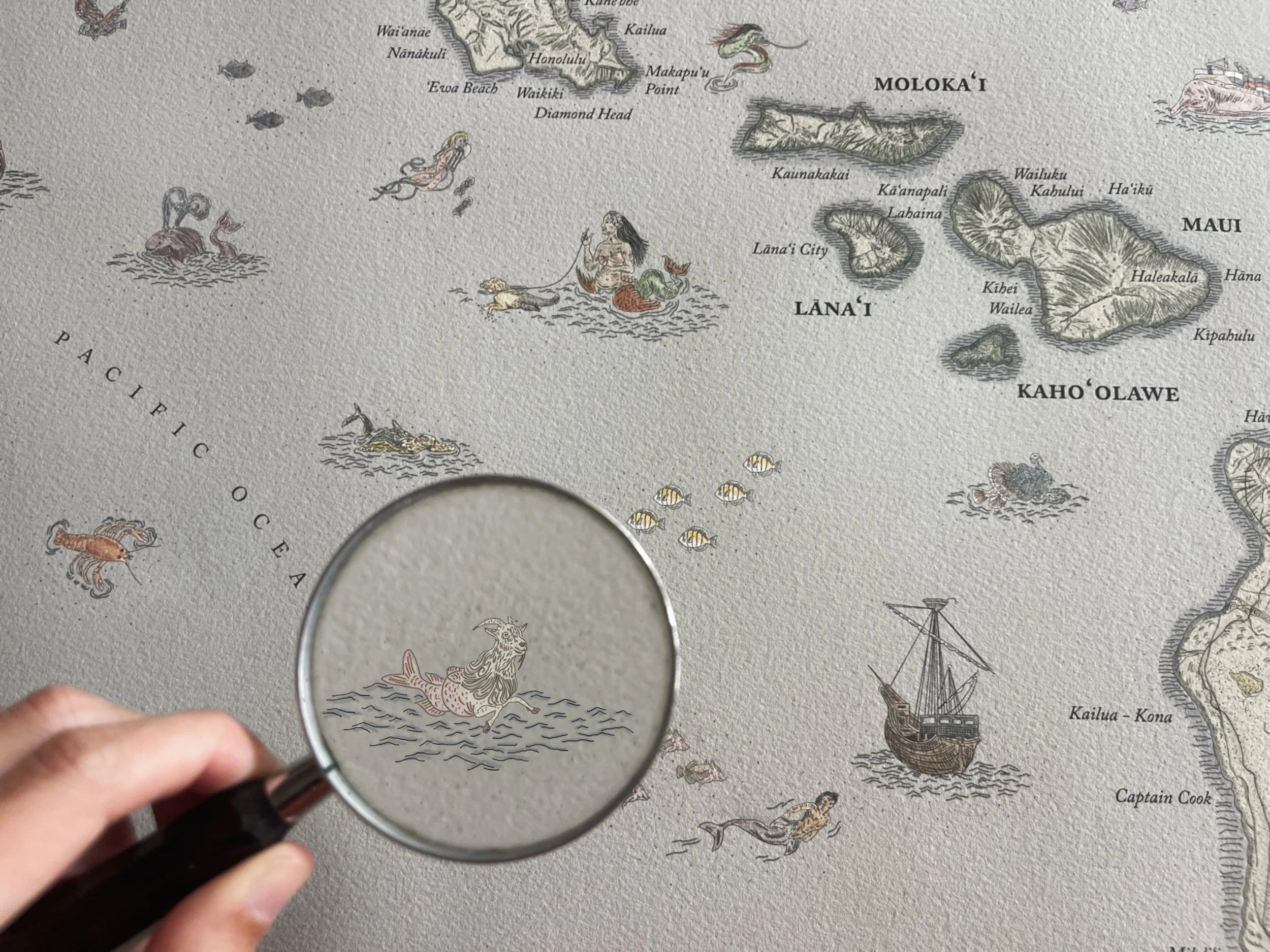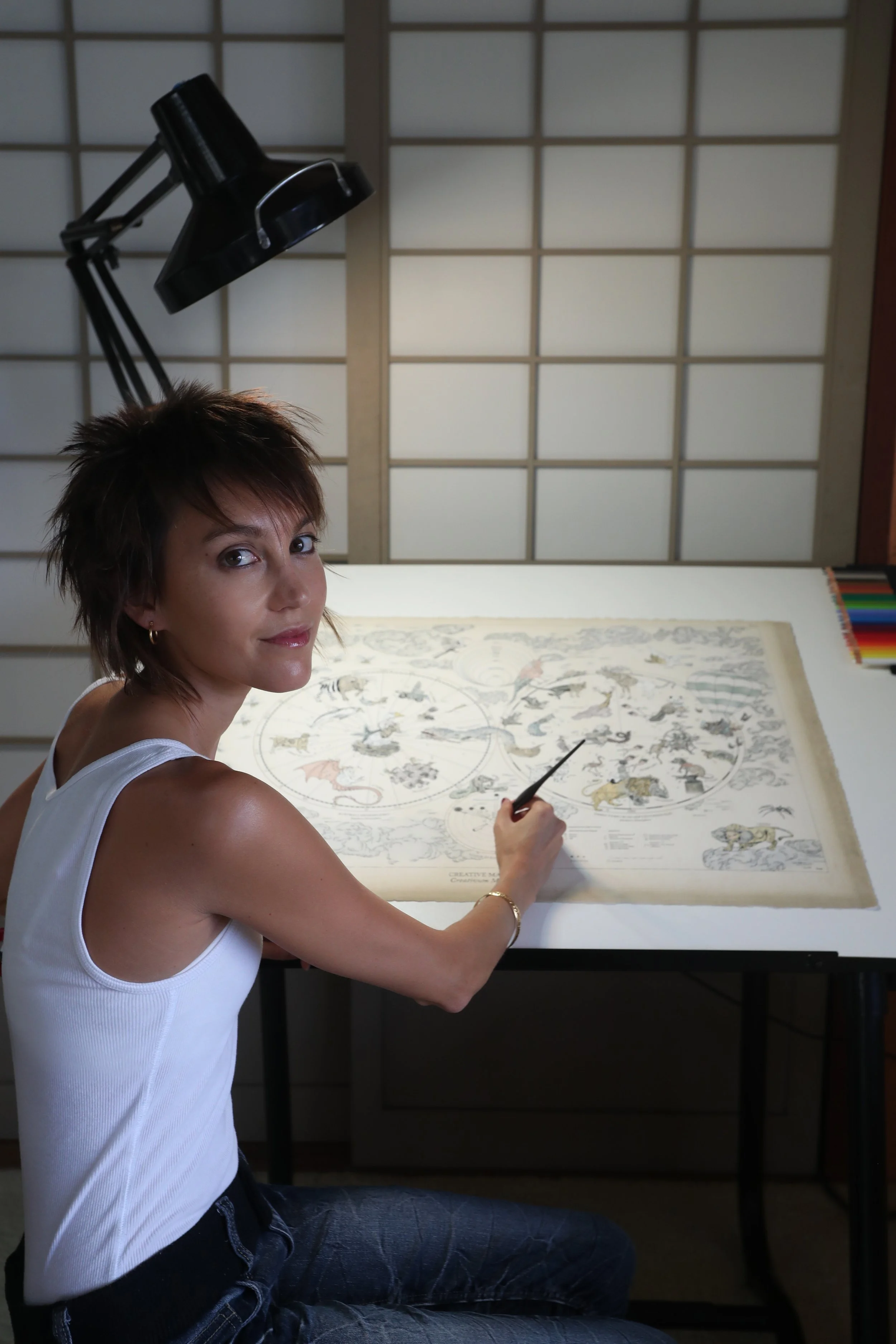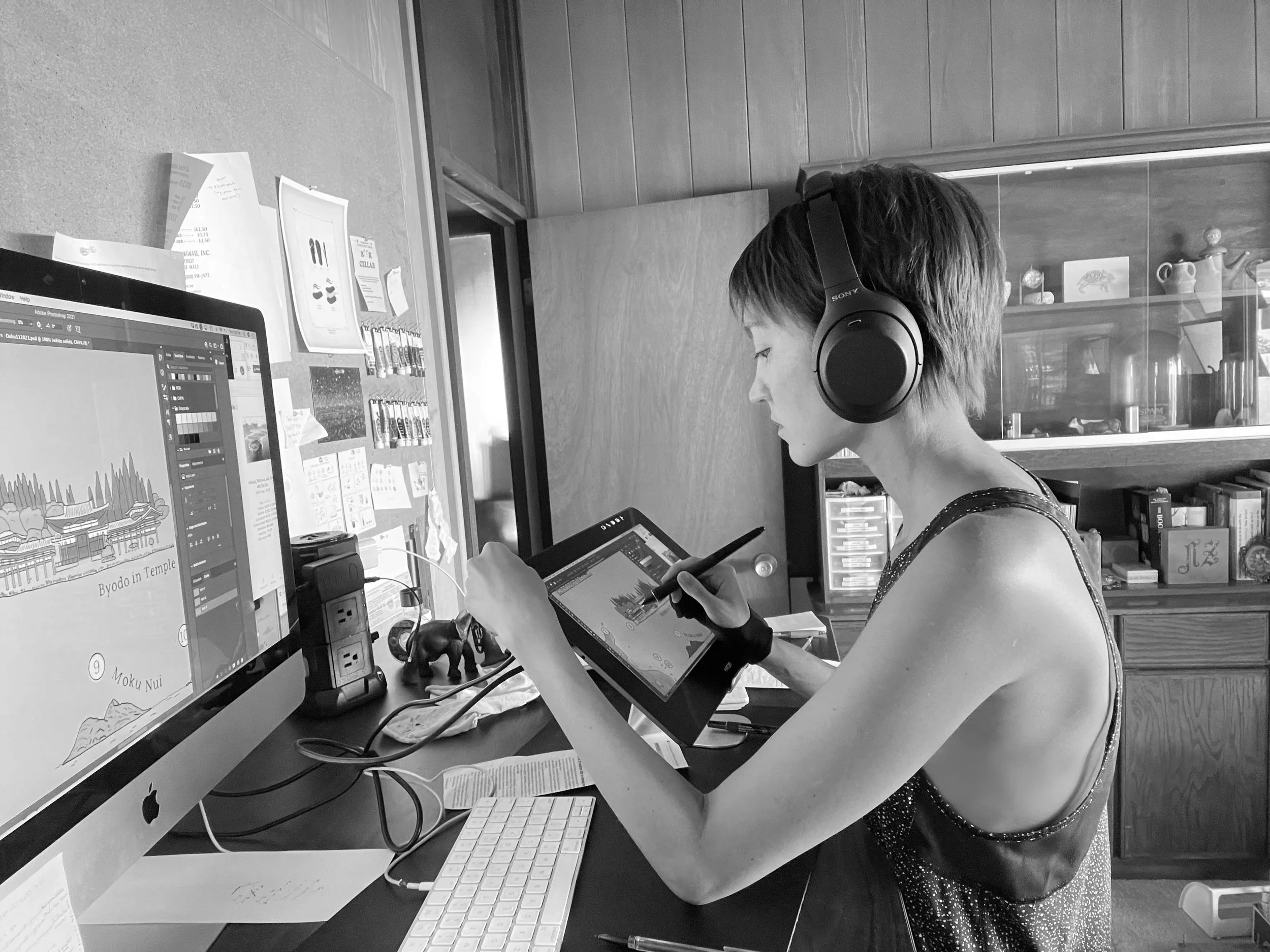Of Cabbages and Kings
“My work has unexpected elements but so does life,” says artist Lauren Trangmar.
A nēnē goose sits at the wheel of a submarine.
With a feathered tricorn perched on its head and a captain’s jacket draped over its shoulders, Hawai‘i’s state bird is peering through the observation dome. Surveying the horizon. Perhaps contemplating where to steer the vessel (more of a saddle-shaped pod, really) mounted atop a humuhumunukunukuapua‘a, Hawai‘i’s state fish, with a metal rudder instead of a tail.
Never mind that submarines aren’t steered with wheels. Or that geese cannot pilot ships. Or that fish don’t typically volunteer as nautical transportation.
These are trivial details in the delightfully impossible world of Lauren Trangmar. Where curious sea creatures don hats and embark on surreal adventures in submarines, narwhals, Volkswagen Beetles, and beyond.
Equal parts taxonomist and artist, Trangmar examines her subjects through a scientific lens. Whether it’s the fauna and flora of Hawai‘i, hybrid creatures of her own invention (like a half-tiger, half-raccoon “tycoon”), or even shave ice or a Spam musubi, Trangmar’s work poses subtle but pointed questions:
How does the world work?
What is the relationship between observation and narrative?
How do visual systems shape our understanding of culture and place?
A special shirt collaboration with Tori Richard inspired by enchanting sea monsters from medieval seafaring maps. (Photo courtesy Trangmar and Tori Richard.)
Lauren Trangmar’s artwork as part of the 2015 Artists of Hawai‘i at the Honolulu Museum of Art. (Photo courtesy Trangmar.)
An assemblage of local artifacts and assorted ephemera created and curated by Lauren Trangmar for her 2018 solo exhibition at ARS Cafe. (Photo by Tommy Shih.)
“I started illustrating after coming across scientific plates and a copy of the medical textbook Gray’s Anatomy. The drawings were so fascinating and amazing; I loved the detail of them,” Trangmar says. “Even as a little kid, I always liked to know how things work.”
It’s a curiosity shaped by a multicultural upbringing. Trangmar was born and raised in New Zealand but spent her summers visiting her grandmother and extended family in Hawai‘i. Her father, an anti-poverty consultant whose work in irrigation and agricultural improvement took him around the world, fostered in Trangmar an interest in systems and environments. Her mother, who spent more than a decade as an executive secretary at the Kahala Hilton before later becoming a medical typist in New Zealand, passed down a special appreciation for the cultural rhythms of the Islands.
Trangmar was living in Christchurch when a devastating earthquake struck in 2011. With a year left in her graphic design degree and her school damaged, she found herself in a city transformed by collapsed buildings and uncertainty. On a whim, she flew to Hawai‘i to visit her grandmother. What was supposed to be a temporary escape from aftershocks became a permanent relocation.
“I wasn’t planning to go back to school,” says Trangmar. “But I started interning for local designers, joined AIGA [the American Institute of Graphic Arts], and people encouraged me to finish my degree.”
While studying at the University of Hawai‘i, Trangmar was given a class assignment: Apply to a variety of art exhibitions to gain professional experience. She submitted an application to the Honolulu Museum of Art’s Artists of Hawai‘i, a competitive juried showcase that spotlights a select group of the state’s most compelling contemporary artists each year. To her surprise, she was accepted.
“I applied thinking, ‘I’m just doing my homework, I’m never going to get in so I don’t have to worry about it.’ Because they only picked something like eight artists a year,” Trangmar says. “When I found out I got accepted, my first thought was: ‘Oh crap. I have to figure out what the heck to do.’”
For six immersive months, Trangmar committed herself to building a body of work — ten pieces and a companion book — that wove together her emerging visual language of hybrid animals, anatomical forms, celestial maps, and cartography. The 2015 Artists of Hawai‘i exhibition not only introduced her distinctive aesthetic to a wider audience, it also marked the beginning of a multifaceted career for Trangmar. Her work can now be found everywhere from gallery walls to limited edition apparel (featuring nēnē riding humu fish, among others) for brands like Tori Richard, as well as prints available at shops such as Nā Mea Hawai‘i, Roberta Oaks, and Nohea Gallery.
“When I was in school, my illustration skills were my strongest. But I consider graphic design to be my superpower,” says Trangmar. “Design allows me to approach every project and plan it out first, then decide what the medium is going to be, whether it’s pen and ink and watercolor, or maybe acrylic, or just digital.”
Artist Lauren Trangmar at her home studio in Kāhala. (Photo by Michelle Chen.)
Two small illustrated blocks created for the Art-o-Mat machine at the HoMA gift shop. (Photo courtesy the artist.)
Today, Trangmar lives and works in the same Kāhala home where her mother and grandmother once lived. “Here, my grandmother taught me local recipes. It took time to better understand Hawai‘i culture and, in a way, how to be local,” Trangmar says. She incorporated what she learned into her drawings, infusing them with details from everyday island life.
One series features playful yet meticulous anatomical breakdowns of beloved Hawai‘i dishes. Poke bowls (dubbed “Raw Pisces Bolus” by Trangmar in faux-scientific jargon) are deconstructed into their component parts: fresh fish, sesame seeds, green onions, rice, and other toppings. Saimin appears as “Noodlus Soupus,” of course, nearly separated into noodles, fishcake, seaweed, boiled egg, and broth.
Another series presents local plants and flowers of the Islands, everything from hibiscus to monarch butterflies to lychee, and highlights their significance in Hawaiian culture. Another series captures ocean scenes (complete with mermaids) and the natural beauty around surfing culture in Hawai‘i. Yet another maps out neighborhoods and landmarks, dotted with visual icons and interesting footnotes peppered throughout. And so on.
“My work has unexpected elements but so does life,” says Trangmar. “I always wanted to be an artist when I was little. I chose to study graphic design because everyone was telling me that drawing or painting doesn’t really have a career path. I pursued design but ended up all the way back at drawing and painting again. So maybe dreams can become real after all.”
To experience more, visit laurentrangmar.com.
Trangmar’s deconstructed spam musubi, complete with a “taxidermied” musubi, as part of a 2018 solo exhibition at ARS Cafe. (Photo by Tommy Shih.)
Wallpaper and custom typography designed for Kula & Kō that tell the story of its process, from plantation-era roots to present day baking. (Photo courtesy Trangmar and Kula & Kō.)
Trangmar illustrates her next masterpiece at home in Kāhala. (Photo courtesy Trangmar.)









